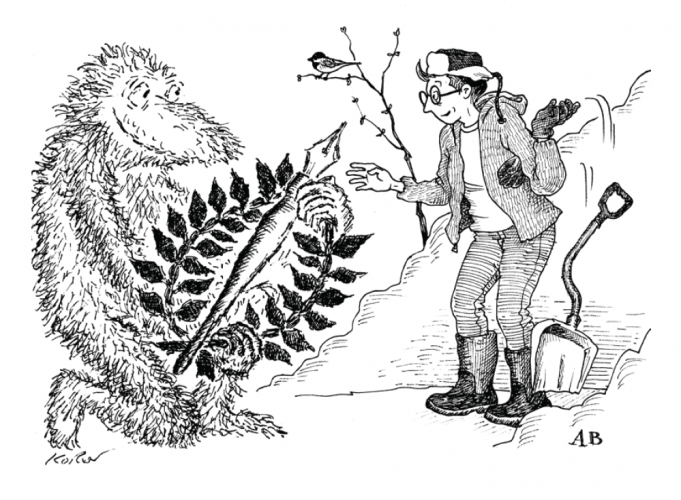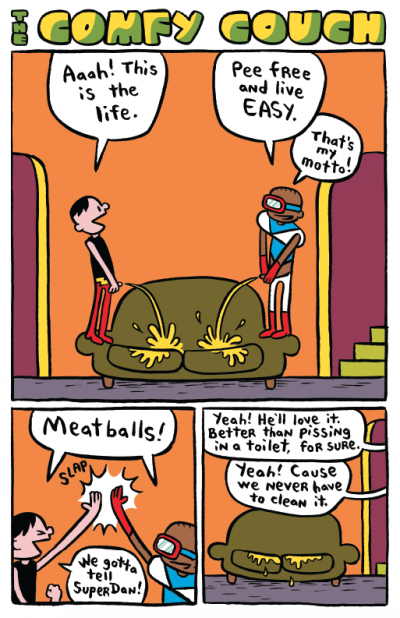The Toon State: Cartoonists Find Sanctuary in Vermont

A joint drawing, a spontaneous “jam,” created by Edward Koren, the previous Vermont cartoonist laureate (holding the pen and laurels), and current cartoonist laureate, Alison Bechdel.
It’s like being named the state flower. —James Kochalka, Vermont’s first cartoonist laureate
Last April, Alison Bechdel, James Kochalka and Edward Koren, three Vermont cartoonist laureates past and present, engaged in a panel discussion at the University of Vermont (UVM) moderated by Pamela Polston, co-founder of Seven Days, Vermont’s alternative print weekly. Bechdel, a MacArthur fellow and renowned memoirist whose retrospective, Self-Confessed! The Inappropriately Intimate Comics of Alison Bechdel, was still on display at UVM’s Fleming Museum, seemed a bit bewildered about her recently conferred title and asked her two co-panelists what exactly was expected of her while she wore the laurels of the laureate. “I feel super guilty,” she said. “No one has asked me to do anything.”
Vermont is the only state with a cartoonist laureate—a title granted every three years at an awards ceremony attended by the congressional delegation at the Vermont State House in Montpelier. As the first to hold the title in 2011, James Kochalka assured Bechdel that she didn’t have to do anything she didn’t want to do. Kochalka, a musician as well as a prolific cartoonist, whose boldly colored and deceptively simple work spans family friendly as well as R-rated fare, went on to mention a litany of workshops and kids programs he conducted across the state while he held the title. Bechdel piped up, “Well, I’m not gonna do that!” eliciting chuckles from the audience. Later on in the conversation, Bechdel assured her hometown fans that, “I love Vermont so much; I’m so grateful to live here. It’s a place I can be queer and a woman and live in the woods and get my work done.”
Alison Bechdel making a giant drawing of one of her cartoon characters on the wall of the Fleming Museum.
Koren, best known for more than three decades of cartooning for The New Yorker, was the elder statesman of the group. Stating his belief that “Cartoonists are not funny people,” he staked his claim as the curmudgeon who grew up unhappy with the way things were and found he could use his cartooning as a form of “gentle needling” rather than hitting people on the head with a sledgehammer. Koren earned an MFA from Pratt Institute in New York City where he embraced his city-guy side, but in 1978, he felt the lure of Vermont and fell in love with a rambling 1840s house in Brookfield that he found through an ad in Country Journal. “Although I’m an urbanite, Vermont has expanded what I know…added a layer of human interconnection that has informed my work. I’m enriched by being in Vermont.” Koren still lives in that same house. He often draws scenes, inspired by his Vermont life, that have an urban edginess just below the surface that find their way on to the pages of The New Yorker. Vermont has also provided an outlet for his original large-scale work through his dealer, Anni Mackay at BigTown Gallery in Rochester, VT. Bearing Witness, a new series of original lithographs of hairy-faced dinosaur-like skeletons inked in Koren’s signature itchy line, was exhibited at BigTown this past May and June.
Historically speaking, cartooning has been a peripheral piece in a traditional art school experience, if it was recognized at all, despite being a passionate artistic interest for many students. To address this void, cartoonist and award-winning graphic novelist James Sturm and his business partner Michelle Ollie founded the nonprofit Center for Cartoon Studies (CCS) in 2004 in the village of White River Junction, VT. Happenstance initially brought Sturm to Vermont, but this soon became an intentional action when he saw the potential for revitalization in the empty, moribund buildings in the historic district of the town. The intrepid pair launched their ambitious program to start a school in the 1929, art deco, former Colodny’s Surprise Department Store. They attracted some of the most accomplished artists in the industry to serve on the faculty including Stephen Bissette who grew up in the hard-scrabble town of Duxbury, VT, and went on to create the award-winning Saga of the Swamp Thing. His comics provided source material for many films, and he was a popular educator in demand as a lecturer and author of both fiction and nonfiction. Another Vermonter, Harry Bliss, best known for his cartoons and covers as a staff artist for The New Yorker, first served CCS as a visiting artist in 2007, the same year Vermont recognized the high-quality of the faculty and curriculum by granting CCS approval to award master’s degrees and certificates.
James Kochalka, excerpt from SuperF*ckers Forever, 2017, drawn with brush and india ink on two-ply bristol and colored in Photoshop. Courtesy of the artist.
In 2011, to serve the needs of its expanding student population, CCS bought the 1934, colonial revival, former town post office, a few doors down from the department store. The post office building now houses the Schulz Library, supported in part by the widow of the library’s namesake and author of the famed Peanuts comic strip, Charles M. Schulz. With its extensive collection of contemporary graphic novels, zines, out-of-print rare collections of gag cartoons, classic newspaper comic strips and a reference section of fine arts, design, animation, illustration and photography, the library is a great resource for both students and faculty.
Jason Lutes, a current CCS faculty star, is preparing for a September release of Berlin, his history-based magnum opus graphic novel 20 years in the making. He wrote the story to “help understand how the Holocaust happened.” Lutes grew up in Montana but always loved Vermont, and when his friend James Sturm started CCS, Lutes jumped at the opportunity to, “come to this amazing place, with its great cartooning weather. In the winter you are forced to hunker down and focus on your work. There are few distractions in White River Junction.”
Many great artists have touted the vital role that solitude plays in art and life. Delacroix once advised, “Nourish yourself with grand and austere ideas of beauty that feed the soul… Seek solitude.” Lutes corroborates that sentiment with the reminder, “all fiction is the work of the imagination.” He says students at CCS are encouraged to “go deep” and to “be auteurs of their own life story.” Roz Chast, another much-loved New Yorker cartoonist takes the advice to “go deep” in Can’t We Talk About Something More Pleasant (2014), a graphic memoir about her elderly parents approaching the end of their lives. The Brattleboro Museum & Art Center hosts an exhibition of her work through September 2018.
Ollie now enthusiastically serves as CCS president. She admits, “Comics had a bad rap and it takes a while for significant change to happen.” It now appears we are entering a renaissance—a new golden age dominated by the graphic novel and pictorial storytelling, with Vermont cartoonists leading the way.
Cynthia Close is a contributing editor for Documentary Magazine and writes regularly about art and culture for several publications.


